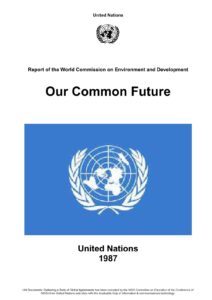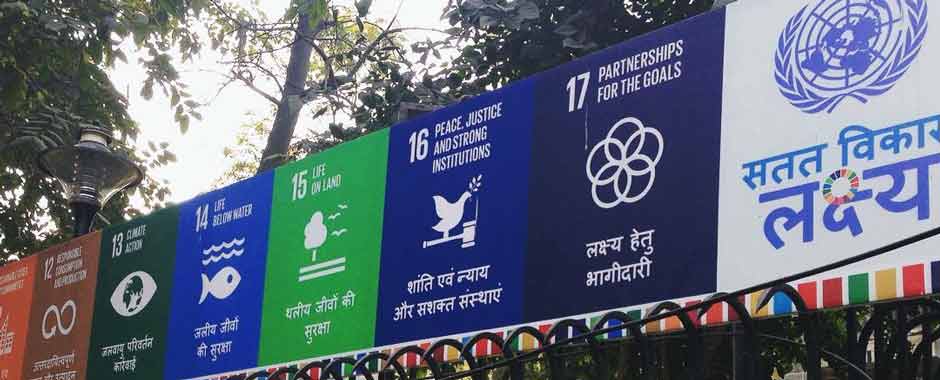by Saurabh Arora and Andy Stirling
The United Nations is 75 years old on 24 October 2020. It’s an unfortunate year to be reaching this milestone. Apart from global pandemic turmoil, there are many critical challenges including mass extinctions of languages and species, rising inequality, and climate disruptions.
Arguably now more than ever, addressing these challenges is central to the UN’s work through initiatives like the Sustainable Development Goals. However, it is difficult to deny that the UN has also often played a role in worsening the same challenges, particularly by promoting development as modernization around the world.
Under modernization, people’s diverse ways of living and knowing may be classified as ‘traditional’. They are inferiorized using representations that impute to them traits such as ‘backwardness’, ‘underdevelopment’, ‘savagery’, ‘irrationality’, ‘inefficiency’, and the ‘lack of capabilities’ to innovate. Through such negative labelling ‘inferiorized’ ways of living and knowing are disqualified from what counts as progress, leaving it to be colonized by modernity.
This coloniality promotes the modern world as superior to all alternatives. Modernity is seen as being made through the singular rationality associated with its own science, technology, industrialization, transportation and communication infrastructures, standardization, individualization, and bureaucratic governance.
This hasn’t always happened without a fight. ’Inferiorized non-modern’ peoples have often refused and resisted modernity, particularly under modern European colonialism. At the same time, many colonized people also made creative use of modernizing ideas such as property rights and nationalism. In general, different regions have tried to adapt and embed modernization into their own contexts, including as part of neoliberal globalization.
Modernity that has been realized as a result takes many different forms. Alternative modernities span capitalist, socialist and communist political-economic systems. Yet they all have one thing in common: overblown imaginations of control – by culture of nature, by governments of nations, by bureaucracy of organizations, by science of reason, by industry of production, by capital of (racialized) labour, by patriarchy of genders, and by metropole of colonies.
Unfortunately, imaginations of control have been integral to the UN’s promotion of modernization as development. Yet within such overarching imaginations, the UN’s democratic ethos of listening and learning have produced some very positive results.
So, on this 75th UN day, we commend its many achievements. Against a backdrop of severe adversity, celebrating hard-won successes can be crucial in nurturing hope. As James Baldwin observed: “the vision people hold of the world to come is but a reflection, with predictable wishful distortions, of the world in which they live.”
If the world in which we live offers nothing to celebrate, then hopeful visions for the future can be rather difficult to imagine. In this extended blogpost, we try to celebrate the UN, but with our own wishful excursions, to nurture hopes for pluralist sustainable futures.
We are not historians of the UN. Much has been written about its achievements. So we will keep our celebrations brief, focusing on the field of sustainable development in which the UN has been a beacon of hope since the 1970s.
Recognizing “man-made harm” at the Stockholm Conference
In 1972, the year of the founding of the United Nations Environment Programme, the UN recognized widespread “evidence of man-made harm” at the Stockholm Conference. This included the “destruction and depletion of irreplaceable resources” and “dangerous levels of pollution in water, air, earth and living beings.”
In this recognition of “man-made harm”, a mythical singular idea of “man” was held to be responsible. Human victims and survivors were made indistinguishable from – apparently as much to blame as – the forces of modernizing development themselves. These forces have included large-scale mining; industrialization of agriculture using toxic chemicals and water-guzzling crops; high-tech weapons for modern warfare within and between nation-states; and millions of climate-disrupting motorized vehicles that burn fossil fuels.
Assigning responsibility to a general and apparently homogenous “man” lets the key culprits off the hook: the particular political-economic forces and interests that promote modernizing development, at the expense of plural alternatives rooted in the diverse ecological and technical knowledge traditions of the world.
In addition, the 1972 Conference declaration held “under-development” to be the cause of “most of the environmental problems” in poorer countries. Only in industrialized countries was it acknowledged that “environmental problems are generally related to industrialization and technological development.”
Yet the same industrialized countries were called upon to help the developing ones to “close the gap”. This kind of linear thinking about closing the gap – or ‘catching up’ – has marred developmentalism since the 19th Century, when many European colonizers initiated their missions to ‘civilize’ the colonized. The latter were ‘inferiorized’ but considered able to climb the ladder of civilization by becoming more modern.
Critically then, despite recognizing “man-made” problems associated with modernity, the UN promoted modernization as a singular direction along which to realize development. Only the modern world was imagined as enabling desirable futures for societies. This thrust was carried into later landmark interventions by the UN for promoting sustainable development.
Saving modernity through Our Common Future?
 Consider the pathbreaking 1987 report Our Common Future (OCF), which gave sustainable development its famous intergenerational definition, with which (to its credit) most readers will be familiar: “…development that meets the needs of the present without compromising the ability of future generations to meet their own needs.” OCF made crucial contributions by linking human well-being to “non-economic variables” such as “clean air and water, and the protection of natural beauty.”
Consider the pathbreaking 1987 report Our Common Future (OCF), which gave sustainable development its famous intergenerational definition, with which (to its credit) most readers will be familiar: “…development that meets the needs of the present without compromising the ability of future generations to meet their own needs.” OCF made crucial contributions by linking human well-being to “non-economic variables” such as “clean air and water, and the protection of natural beauty.”
Like the Stockholm Conference, OCF highlighted the unsustainability of modernizing industrialization along the lines of so-called developed countries. Yet, once again, the UN proposed to continue with modernization, based on new developments in technology and science, including transport and communication infrastructures. These positive developments were assumed to have bestowed on modern humans the “power to reconcile human affairs with natural laws”.
For example, this power was observed to allow more efficient use of resources for modern energy generation (and energy efficiency of appliances) and of technological inputs in food production. The dominant understanding of sustainable development in OCF was that of more efficient modernization: “to produce more with less.”
Overall, OCF appears to be geared towards saving the modern world, by improving the efficiency of modernizing developments for “a new era of economic growth”. But what is ‘efficiency’? It is simply a proportion between apparently given variables. If “non-economic variables” are indeed crucial for human well-being, then why not look beyond the modern world for imaginations of well-being that are not tied to the quest for economic growth?
While directions of development based on diverse traditions of well-being were marginalised in OCF, the existence of alternatives to modernization was clearly acknowledged. Many of these alternatives were also observed to be under threat by continued modernization.
For instance, vulnerable communities of “indigenous or tribal peoples” were noted as “repositories of vast accumulations of traditional knowledge and experience that links humanity with its ancient origins.” Yet these vast accumulations were excluded from shaping directions of development that would offer alternatives to modernization.
People considered ‘indigenous’ were consulted through public hearings in the process of preparing the OCF. In these hearings, representatives of ‘indigenous’ people opposed their displacement from ancestral lands in the name of development. They observed their peoples’ lack of participation in constituting plural directions of development. For example, the president of the Native Council of Canada argued that the people he represented “are the first to detect when the forests are being threatened, … the first to feel the pollution of our waters … [but] are the last to be consulted about how, when, and where developments should take place”.
Governing hope with the Sustainable Development Goals?
Rolling forward three decades, it is a very positive feature of the 2015-30 Sustainable Development Goals (SDGs) that this time around, representatives of ‘indigenous’ and marginalized communities – and of many other groups across different countries – were consulted. Indeed, the SDGs are arguably the most comprehensive achievements of the UN in this field.

With 17 goals and 169 targets, the range of issues addressed by the SDGs is truly impressive. In the preamble to the 2030 Agenda for Sustainable Development, the UN and its member countries appear “determined to take the bold and transformative steps which are urgently needed to shift the world on to a sustainable and resilient path.”
The UN does not state that the world invoked in this new initiative is modernity. However, it overlooks the fact that other worlds – for example, of nomadic pastoralists or forest-dwelling Amazonians – are not the ones urgently needing a shift to ‘a sustainable and resilient path’. None of these multiple possible other worlds are seen as helping, in their own right, to constitute new directions of sustainable development.
For instance, shamanic traditions are repudiated for their esoteric ways of knowing and systems of knowledge. But pragmatic capitalism nonetheless often quietly recognises the fruits of these knowledges when it seeks to patent and profit from insights about the health benefits of many natural materials. Only when clothed in the trappings of modernity – for instance as pharmaceuticals – are these ‘nonmodern’ knowledges anonymously upheld.
Despite the best of intentions, then, the UN’s SDGs seem implicitly attached to protecting existing modernity in the name of saving the world. Just like OCF, the existence of alternatives to industrial modernization is recognized in the SDGs. But under chosen metrics, they appear ‘inferior’ as compared to a new and ostensibly sustainable modernity.
Thus, modernization is still the direction for development that is promoted. This is evident in the definition of many goals and targets, but perhaps most explicitly in Goal 7 directed at universal access to “modern energy services”. Other goals and targets promote modern information and communication technologies as enabling ‘gender equality’, ‘quality education’, ‘resilient infrastructures’, ‘sustainable industrialization’, and the overall acceleration of ‘human progress’.
Even for the goal of ending hunger, modern infrastructure, research, extension, and gene banks are promoted to “enhance agricultural productive capacity”. Within the same goal, target 2.3 calls for doubling agricultural productivity of (women and ‘indigenous’) smallholders by 2030, thereby problematizing small-scale agriculture as insufficiently productive.
Similarly, the UN’s framework of indicators for the SDGs, which includes metrics such as number of children attending formal schools or literacy rates, often score ‘indigenous’ people as lagging behind a population’s average. This again problematizes ‘indigenous’ people as deficient.
Providing the framework for this discourse of deficiencies, the UN inadvertently plays a part in the assimilation of ‘indigenous’ peoples into modernity. A modernity that is now aiming for sustainability by 2030, through the SDGs. A new form of sustainable modernization is thus pushed to the forefront for saving the world.
Central to this singular world saving itself are cutting-edge technological developments and scientific research. Yet possible adverse effects of these techno-scientific innovations are downplayed. Uncertainties are suppressed. And alternatives based on knowledges and materials of diverse practitioners such as agroecological smallholders, forest-dwellers, shamans, and nomadic pastoralists are marginalised.
Embracing many worlds
Despite centuries of disqualification and destruction of (formerly) colonized peoples’ lifeways, the earth is still home to many other worlds that have resisted assimilation into modernity. These represent the earth’s pluriverse, which may be defined as ‘a world in which many worlds fit’, using the Zapatistas’ words.
Each of these worlds is constituted by its own ways of relating between different beings, human and nonhuman. Each world produces its own languages and techniques that mediate relations between humans and with nonhumans. Through these relations, diverse knowledges are produced and practices are performed to connect and communicate across categorical divides between nature and culture. Each world is thus composed by specific ways of knowing and living.
As noted above, the globalized modern world is underpinned by control and domination of humans and nonhumans it mythologizes as inferior. In contrast, other plural worlds may be underpinned by hospitality and kinship towards those considered different. They may also approach animals and plants as beings with agency very similar to humans.
For example, consider Viveiros de Castro’s account of other worlds in Amazonia that approach animals and humans as sharing the same culture, the same soul. Animals are persons who have their own ‘spirit’ masters with capacities analogous to human shamans. There is nothing culturally distinctive about humans as a species.
Due to their shared culture, humans and animals approach their surroundings in the same way. But the things that are seen differ between humans and animals. For example, “what to us is blood, is maize beer to the jaguar; … what we see as a muddy waterhole, the tapirs see as a great ceremonial house.”
Worlds in the making
Diverse ways of living and knowing, such as in Amazonia, are constituted by the worlds they are embedded in. In turn, ways of knowing and living make their worlds of a pluriverse. The plural worlds are thus continually in the making.
This making of worlds is also contingent on the situations and contexts in which we as observers of worlds are embedded. Depending on how we approach reality, what perspectives we adopt and what tools we use, a different pluriverse will be traversed by us. And no matter how comprehensive are our techniques to map the Earth’s pluriverse, our efforts will always be incomplete and imbalanced.
Thus, whilst no complete charting of the pluriverse is ever possible in any single definitive sense, each of us can definitely embrace a pluriverse beyond modernity. This is not about excluding or eradicating every constituent strand of modernity itself. That would – ironically – perpetuate the same reflex of dominating control. In a pluriverse, these strands can admit uncertainty and cultivate humility – like others – to weave and entangle in a rhizomic multiplicity of ways.
So, a country – even the earth as a whole – can appear to be a single technologically interconnected world, encompassed by modernity. But both beyond and within it, there are always other worlds to be embraced, real and possible, historical and contemporary.
To sustain these worlds of an embraced pluriverse beyond modernity, multiple ways of knowing and living need to be supported. This support is not something to be engineered or furnished by ‘modern saviours’ – or for that matter, individualised heroic saviours of any kind. Hero stories can now be left behind.
Embracing a pluriverse is a rather more humble practice, situated in distributed and convivial struggles that strive for three interrelated collective purposes:
- To nurture the diversity of ways of knowing and living that make many worlds thrive in different places – by unshackling modernity from a coloniality that ‘inferiorizes’, controls and destroys other worlds, using overbearing singular ideas of ‘rationality’ or ‘efficiency’ and using racial, casteist, gendered, ethnic, religious or other hierarchically ordering categories;
- To respect each of these ways of knowing and living as requiring its own webs of relations between human and nonhuman beings, which stand on their own terms (rather than as lesser versions of something else) – for instance being conditioned more by care and hospitality than by control and domination;
- To acknowledge all these ways of knowing and living as contributing their own possible directions for progress towards sustainability – rather than promoting sustainable development as ‘improvement’ or assimilation through modernization.
Where a pluriverse is embraced, hope is no longer colonized by modernity. Thus can modernity itself be liberated from its own self-destructive dissonance and denial of the domination it inflicts – and the ever more futile ambitions to control that it pursues.
The challenge then, is not to ‘save the world’ in any supposedly singular categorical way. A more flourishing way for life is to embrace a pluriverse, to celebrate and nurture and interconnect the multiplicity of worlds.
Despite the many flaws and compromises – and the oppressive weight of the global hegemony in which it struggles – it is a remarkable achievement of the UN, that it can help create space for this growing pluriverse, to which a truly transformative agenda for sustainability can lead.
